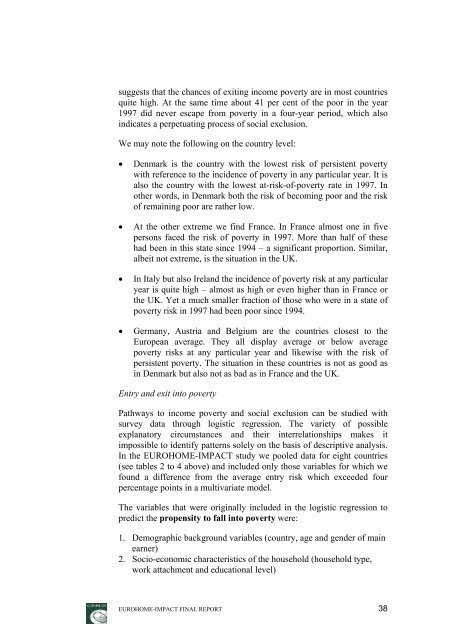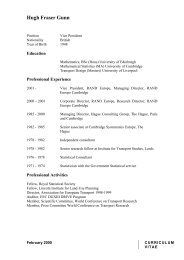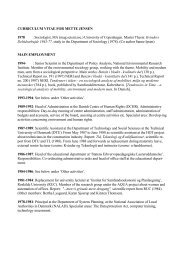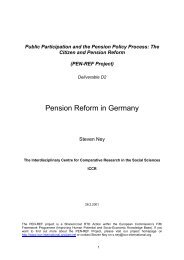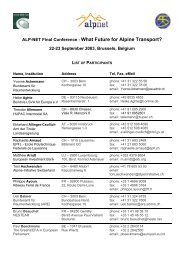The Housing Dimension of Welfare Reform - the ICCR
The Housing Dimension of Welfare Reform - the ICCR
The Housing Dimension of Welfare Reform - the ICCR
You also want an ePaper? Increase the reach of your titles
YUMPU automatically turns print PDFs into web optimized ePapers that Google loves.
suggests that <strong>the</strong> chances <strong>of</strong> exiting income poverty are in most countries<br />
quite high. At <strong>the</strong> same time about 41 per cent <strong>of</strong> <strong>the</strong> poor in <strong>the</strong> year<br />
1997 did never escape from poverty in a four-year period, which also<br />
indicates a perpetuating process <strong>of</strong> social exclusion.<br />
We may note <strong>the</strong> following on <strong>the</strong> country level:<br />
• Denmark is <strong>the</strong> country with <strong>the</strong> lowest risk <strong>of</strong> persistent poverty<br />
with reference to <strong>the</strong> incidence <strong>of</strong> poverty in any particular year. It is<br />
also <strong>the</strong> country with <strong>the</strong> lowest at-risk-<strong>of</strong>-poverty rate in 1997. In<br />
o<strong>the</strong>r words, in Denmark both <strong>the</strong> risk <strong>of</strong> becoming poor and <strong>the</strong> risk<br />
<strong>of</strong> remaining poor are ra<strong>the</strong>r low.<br />
• At <strong>the</strong> o<strong>the</strong>r extreme we find France. In France almost one in five<br />
persons faced <strong>the</strong> risk <strong>of</strong> poverty in 1997. More than half <strong>of</strong> <strong>the</strong>se<br />
had been in this state since 1994 – a significant proportion. Similar,<br />
albeit not extreme, is <strong>the</strong> situation in <strong>the</strong> UK.<br />
• In Italy but also Ireland <strong>the</strong> incidence <strong>of</strong> poverty risk at any particular<br />
year is quite high – almost as high or even higher than in France or<br />
<strong>the</strong> UK. Yet a much smaller fraction <strong>of</strong> those who were in a state <strong>of</strong><br />
poverty risk in 1997 had been poor since 1994.<br />
• Germany, Austria and Belgium are <strong>the</strong> countries closest to <strong>the</strong><br />
European average. <strong>The</strong>y all display average or below average<br />
poverty risks at any particular year and likewise with <strong>the</strong> risk <strong>of</strong><br />
persistent poverty. <strong>The</strong> situation in <strong>the</strong>se countries is not as good as<br />
in Denmark but also not as bad as in France and <strong>the</strong> UK.<br />
Entry and exit into poverty<br />
Pathways to income poverty and social exclusion can be studied with<br />
survey data through logistic regression. <strong>The</strong> variety <strong>of</strong> possible<br />
explanatory circumstances and <strong>the</strong>ir interrelationships makes it<br />
impossible to identify patterns solely on <strong>the</strong> basis <strong>of</strong> descriptive analysis.<br />
In <strong>the</strong> EUROHOME-IMPACT study we pooled data for eight countries<br />
(see tables 2 to 4 above) and included only those variables for which we<br />
found a difference from <strong>the</strong> average entry risk which exceeded four<br />
percentage points in a multivariate model.<br />
<strong>The</strong> variables that were originally included in <strong>the</strong> logistic regression to<br />
predict <strong>the</strong> propensity to fall into poverty were:<br />
1. Demographic background variables (country, age and gender <strong>of</strong> main<br />
earner)<br />
2. Socio-economic characteristics <strong>of</strong> <strong>the</strong> household (household type,<br />
work attachment and educational level)<br />
EUROHOME-IMPACT FINAL REPORT 38


